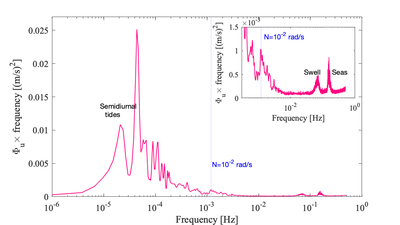Time and length scales of turbulence: Difference between revisions
From Atomix
m Added sketch |
|||
| Line 1: | Line 1: | ||
The length and time scales of turbulence must be considered when analysing turbulence measurements. The scales at which the turbulence subranges, both the viscous and inertial subrange, exist depend on the flow properties. | The length and time scales of turbulence must be considered when analysing turbulence measurements. The scales at which the turbulence subranges, both the viscous and inertial subrange, exist depend on the flow properties. | ||
[[File:Velocity timescales.png|400px|thumb|Example velocities from an instrument impacted by tides and surface waves, which are presented as variance preserving spectra. The instrument is tens of meters off the bottom on the continental shelf in stratified waters with a buoyancy period of 9 min.]] | |||
== High wavenumber limit== | == High wavenumber limit== | ||
Revision as of 18:44, 1 December 2021
The length and time scales of turbulence must be considered when analysing turbulence measurements. The scales at which the turbulence subranges, both the viscous and inertial subrange, exist depend on the flow properties.

High wavenumber limit
For instance, the wavenumber (length scale) limits depend on the sought quantity <math>\varepsilon</math>, and also the kinematic viscosity.
Low wavenumber limit
Timescales
Can use the equation <math>\tau=(L^2/\varepsilon)^{1/3}</math>
